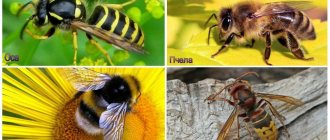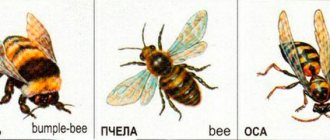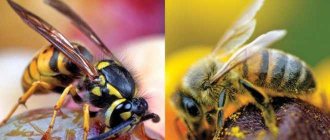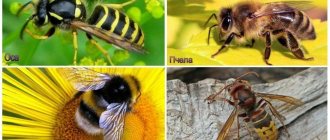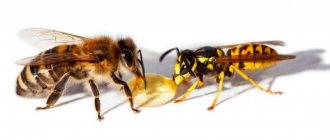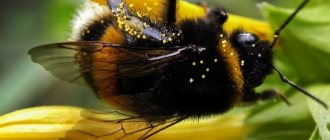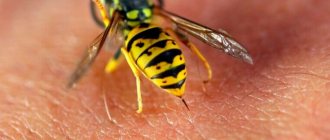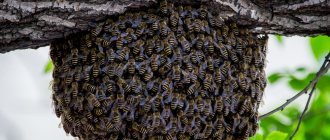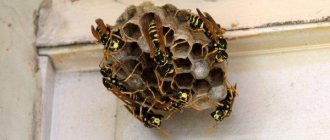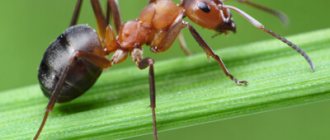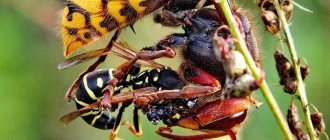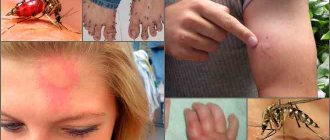09.12.2020
Each of us has encountered representatives of the order Hymenoptera - bees, hornets, wasps, bumblebees. Some of the most dangerous representatives are wasps and hornets. How to distinguish them from each other and how to understand which of them are more dangerous? To answer these questions, we will consider each type in detail.
- Appearance
- Nest structure
- Lifestyle
- Why are they dangerous for humans?
- What to do if bitten by a wasp or hornet
- How to get rid of a hive
Preventing insect stings
It is difficult to avoid encounters with insects outside the city, since there a person finds himself visiting nature. Therefore, it is worth carrying allergy pills with you. When visiting the apiary, wear special clothing. When making jam, close the windows so as not to tempt wasps and bees. When picking fruit in the garden, protect your hands with thick gloves or inspect each fruit for insects.
The favorite delicacy of wasps, hornets, and bees is ripe sweet fruits: pears, plums, apples
When relaxing in the forest or on the river bank, be careful:
- when looking for a parking place, first check to see if there are insect nests nearby;
- do not walk barefoot;
- do not disturb the houses of wasps and hornets, they will certainly attack;
- when they see a stinging insect, they behave calmly and do not wave their arms so as not to provoke aggression;
- the biting insect is not killed; the body of the killed one exudes an enzyme that will provoke an attack by its relatives.
When going outdoors, do not use perfumes containing apple and banana fragrances. The listed odors attract hornets and wasps.
Stinging insect bites are treated with compresses and ointments. In case of allergies, antihistamines are used. If after a bite the victim’s breathing is impaired and his consciousness is swimming, immediately call an ambulance
To avoid insect attacks, be careful when picking fruit, making jam and finding a place to camp in nature.
Hornets
The most dangerous relatives of my favorite bees for humans. Not only are they intimidating in size (they can be up to 6 cm in length), but they also do not have serrations on their stingers. This means that after being bitten they do not die, but continue to sting until the poison runs out. And they have a lot of it. So much so that meeting them can be fatal.
But despite the horrors that I told you about, you cannot destroy their hives when you meet them. Hornet larvae feed on insects. A large family of hornets can eat half a kilo a day. So without them, the ecosystem will be very disrupted.
Their houses are very ugly on the outside and extremely slender on the inside. Outwardly, they resemble the thermal insulation on old panel houses - sloppy, pimply heaps. Inside such houses there are even compartments with honeycombs of several floors.
I think I wrote about everyone. If I missed anyone, tell me. I missed your comments.
Can bees harm you?
Most of them can. “Bee stings typically result in pain and a localized reaction of mild swelling, redness and itching at the site of the sting,” says Troiano. “However, for a person who is allergic to bee stings, even one sting can be life-threatening.”
When a bee stings you, its stinger detaches and continues to pump you full of venom until you remove it, which is not very pleasant. The pain does not last forever, but the bite usually causes swelling and itching.
It's worth noting that honey bees usually die after stinging a person, and ground bees are not aggressive, so the chances of being stung by one are low.
Lifestyle and behavior
The difference between insects is visible even in flight.
The bees fly calmly, slowly. Wasps - hastily, intermittently, suddenly stop, freeze.
Hornets fly more calmly. The flight of bumblebees is heavy, leisurely, with a low hum.
Insects live in different ways.
Bee
Bees create families where they adhere to strict subordination.
Domestic insects live in hives built for bee colonies by the beekeeper.
For wild bees, tree hollows and rock crevices are places where you can build a house.
The queen bee is surrounded by attention and care from other residents of the hive; no one cares for the wasp queen, she is left to herself. Bee house. Bee house
Bee house
Solitary bees are less common. They live in burrows in the ground, sometimes the thick stems of individual plants and tree crowns serve as their home.
The inner walls of the bees' home are treated with wax (a thin layer). Nectar and pollen are also carried there. The eggs are laid on supplies and the hole is covered with earth. Then they set up a new one.
Bee offspring eat nectar and pollen. The larvae form into a pupa, from which a mature bee grows.
Wasp
Many species of wasps live in disciplined families, where they follow strict obedience: each individual performs its duties.
Wasp nests are not as solid as bee nests, since they are built from chewed grass and rotten wood. Wasps attach their homes to the walls of houses and the eaves of buildings.
First, the queen creates one cell and lays an egg there.
The first one is slowly overgrown with other cells (like honeycombs in beehives). The hatched wasp larvae are fed with rough food (crushed insects, caterpillars). When the larvae eat, they produce saliva. It is collected by mature individuals (tropholaxis process).
As the larva grows and develops, it clogs the cell, forming a cocoon. A mature wasp is selected from it (usually in the last month of summer). But not all larvae mature; some of them die without surviving the winter.
The used cell is cleaned, and again the female lays an egg there.
Vespiary
Hornets have similar nests.
Hermits are often found among wasps. Singles do not arrange homes. Females find food in the ground: beetle larvae, immobilize them and use them as a place to lay eggs.
Bumblebees live in groups of no more than two hundred individuals in each group. They nest in holes left by rodents and are suitable for homes and tree hollows.
How to get rid of earth wasps
Ground wasp.
Certain species of wasps build their burrows in the ground. Such burrows can be located near outbuildings, right on the beds or near firewood sheds. If you notice such earthen insects, you need to act as carefully as possible. Wait until dusk, then pour boiling water over the nest and try to drown them all in the water. But you shouldn’t try to cover up the entrance. These smart insects usually build underground nests with numerous exits, which allows them to leave the hole in a variety of ways if there is danger.
Habitat
Bees can be found wherever there are flowering plants. You cannot see them in a hot desert or in places with a cold climate.
The most favorite place where bees like to settle are mountain crevices, abandoned holes or hollows of large trees. For their hives they choose only reliable support. It is very good if there is a body of water nearby. It is better with running water - a river or stream, but not a swamp. The hive must be reliably protected from strong winds.
The habitat of wasps is quite extensive. They can mainly be found in the Northern Hemisphere. The largest number of wasps on Earth is concentrated here. These insects try to build a nest closer to humans and trees. This allows them to easily and quickly obtain food and build nests and hatch larvae.
Where can you find a bumblebee? Where can you not meet him? The ability to maintain a high body temperature allowed the bumblebee to live even in the north. They fly to Chukotka, Greenland and Alaska. And all thanks to interesting thermoregulation, which at the same time does not allow them to live in the tropics. Bumblebees are found in North America, northern Eurasia and in places where there are mountains. Nevertheless, two species of these insects were found that took root in the tropics of Brazil.
Lifestyle
The lifestyle of both types of insects is similar. These are social insects that live in large colonies with a clear hierarchy. The family has a queen, males, and workers. Each individual strictly performs its own function, which allows the colony to quickly increase its numbers. The queen and males are engaged in the reproduction of offspring, workers obtain food and build hives. The bulk of the colony are working individuals that ensure the survival of the queen.
Wasp on fruit
Both insects are predators. They feed on smaller species. A wasp, for example, can destroy bee hives, obtaining honey as food, and also taking bees into its hive to feed the larvae. Hornets also eat small caterpillars, ants and other insects.
In addition to small insects, both species love sweets, such as fruits, berries, sweet drinks (kvass, compote, lemonade, juices), desserts, rotten foods, jam, honey, syrups.
What is the difference between a bumblebee, a hornet, a wasp, a bee and their bites
It is more correct to say that insects sting and do not bite humans. Only female wasps, hornets, bumblebees or bees attack. Modified ovipositor - only females have a sting. It is located at the back of the underside of the abdomen. Piercing the body of the victim, the insect simultaneously injects poison through a cavity in the sting.
Wasp
At the end of summer, wasps swarm around fruit trees. The insect resembles a striped fly: a shiny black and yellow body 15 to 18 mm long, a shaggy small head with powerful jaws and two pairs of brownish wings. Between the abdomen and the sternum there is a thin joint, which is popularly called the “wasp waist”.
When a threat arises, the insect plunges a sharp, smooth sting into the human body, but does not leave it there. Having stung 1–5 times, the wasp flies away. Unlike other insects, sometimes a wasp can bite with its jaws. Such a bite does not cause serious consequences, since it occurs without the introduction of poison. Insects live alone and in colonies in paper nests consisting of egg cells.
The size of a wasp nest shows how many workers there are in the colony
Hornet
Some insects fly through the air like fighter jets. We are talking about hornets, which differ in appearance from wasps with a large head and rounded abdomen. At rest, the insect's wings fold along its back. The hornet stings like a wasp - without releasing its sting. Hornets build brown nests, while wasps build gray nests. Insects attack the one who tries to destroy the nest.
The top of the hornet's head is larger than that of a wasp and is brownish rather than black in color.
Bee
Disturbed bees attack humans everywhere except Antarctica. The insect's body is dark with ocher stripes, hairy and more rounded than that of a wasp. The proboscis-shaped mouth is used to suck nectar from flowers. The difference between a bee is that its sting is not removed after a sting, but remains in the wound along with part of the abdomen, which pulsates, continuing to inject poison
Due to damage to a vital organ, the insect dies within 3 minutes
Villi on the body of a bee help the adhesion and transfer of plant pollen
Bumblebee
The largest of the stinging striped insects are bumblebees. Their bodies are larger, rounder and fluffier than those of bees and wasps. The stripes on the black belly are orange or yellow. The difference from other insects is the pollen baskets on the hind legs, surrounded by hard, straight hairs. The mechanism of a bumblebee bite is similar to that of a wasp and a hornet: the sting is smooth and does not remain in the wound.
The genus Bumblebees belongs to the family of true bees.
How to understand who bit
When examining the bite site, they find out whether the wound is clean
If a black sting with jagged edges, like a saw, is found in the wound, it means that the person has been punished by the bee for his carelessness. But other insects also leave sting fragments if you swat them at a crime scene. In the absence of a stinging weapon, it is impossible to understand who bitten, since the reaction of each person’s body is individual
In the absence of a stinging weapon, it is impossible to understand who bit, since the reaction of each person’s body is individual.
The biting insect is indirectly determined by the degree of pain of the bite. But anyone who has suffered at least once from stinging insects can make comparisons. The most painful sting is from the hornet, followed by the wasp, bumblebee and bee.
A hornet's sting is less toxic than a bee's, but it can sting several times.If a person has not encountered these insects before, it is worth monitoring the speed and severity of the allergic reaction. The most powerful poison is the wasp, which quickly enters the bloodstream and causes illness. At the sting site for 3–15 minutes. edema develops.
A bee sting is characterized only by local manifestations. The swelling from the bite is smaller and grows more slowly. True, in the event that a person does not suffer from individual intolerance.
Precautionary measures
Do not delay treatment: if a strong reaction to a sting occurs, you should consult an allergist.
When treating a bite, the following are not allowed:
- attempts to suck or squeeze out poison from the wound;
- picking with a needle;
- rubbing or scratching the skin;
- cauterization of the bite point;
- applying earth.
The suffering of the bitten person is not alleviated by alcohol. To improve your well-being, it is better to lie down and place a salt or cold compress on the bite site. Physical activity is prohibited.
If you drink alcohol after being bitten, the poison will spread throughout the body even faster.
Stung by a wasp: first actions
This is not the first generation of parents who have used proven first aid actions for a wasp sting. The main thing is to do everything quickly.
What to do first? It is important to leave the scene of the attack, but you should not try to kill the wasp, especially if it is not alone. Such actions will most likely cause another attack
The sting may contain a large number of bacteria, so it is recommended to treat the bite site with an antiseptic
To do this, you can use hydrogen peroxide, alcohol, or, as a last resort, soap and water. To stop the spread of toxins, the bitten arm or leg is bandaged over the wound with a tourniquet or scarf. Drinking plenty of liquids: tea, compotes, water helps speed up the process of removing poison. You can relieve the pain by bandaging the bite site and putting something cold or just ice on top. Half an onion, tomato or apple also relieves symptoms well: you need to put it on the site of the bite.
After providing first aid, you should continue to monitor the condition of the victim, since swelling can begin either immediately after the bite or a day later. If the wound is very swollen (1.5-2 times) and the person complains of feeling unwell, consult a doctor.
Treatment for normal reactions to bites
What is more important is not the name of the culprit of the sting, but the nature of the reaction to the bite, since the treatment of wounds from any stinging insects is the same.
First aid
First of all, the victim is taken away from the site of the insect attack, placed in a horizontal position, and the collar and belt on the waist are loosened. Even with a normal reaction to insect venom, with multiple bites or stings in the area of the face, neck, mucous membranes, first take allergy pills.
If there is a sting in the wound, rub it with a napkin using stroking movements or pry it with a blunt object with a thin surface: a table knife or a bank card. If you grasp the sting with tweezers or your fingers, the remaining venom will be squeezed into the wound.
The bee sting must be carefully removed without applying pressure.
Then the following steps are performed:
- the wound is washed with running water and soap;
- treated with an antiseptic: hydrogen peroxide or alcohol;
- neutralize the poison with a lotion of lemon juice, vinegar solution: 1 tsp. per glass of water.
To reduce the rate of spread of toxins, apply a heating pad or plastic bag with ice to the affected area of skin for 10–12 minutes.
An ice compress for bites can be applied 3 times a day, pausing for 3 hours.
What to do if you are bitten by stinging insects - video
Drug treatment
To alleviate the patient's condition, the bite site is lubricated with ointments containing analgesic and anti-inflammatory components. Medicines used:
- Fenistil cream-gel relieves allergies, pain, itching;
- Menovazin solution or ointment provides long-term pain relief to the bite site;
- Boro Plus cream heals the wound and restores the skin;
- Levomekol ointment disinfects and relieves inflammation;
- tincture or ointment with calendula resolves swelling;
- Zvezdochka balm relieves pain.
Vietnamese balm Zvezdochka quickly relieves itching from wasp, hornet, bumblebee and bee bites
Folk remedies
The symptoms go away on their own within 2–4 days, but the bite site hurts and itches. Folk remedies are applied to the wound:
- a paste of baking soda and water is left until dry;
- half a fresh onion for 20 minutes;
- cube of wet refined sugar for 30 minutes;
- keep menthol toothpaste or foam laundry soap for 5 minutes;
- a napkin moistened with aloe or raw potato juice;
- salt compress: 1 tsp. salt per glass of water;
- plantain leaf.
Aloe juice soothes irritated skin and relieves swelling
Difference between bee and bumblebee
The bee and the bumblebee are united by their belonging to the Hymenoptera. But while they have biological similarities, insects are also different from each other in many ways. So, what is the difference between a bee and a bumblebee?
Bee
Related to wasps and ants, bees are flying insects found on every continent except Antarctica. Their diet is nectar and pollen - sources of energy and nutrients. The proboscis helps insects obtain nectar. They also have antennae divided into segments. Of the two pairs of wings present, the rear ones are smaller. Bees are essential plant pollinators.
Bumblebee
The bumblebee is not only close to honey bees, but is itself classified as a member of the family of true bees. It has a high tolerance to cold due to its ability to warm up by frequently contracting its muscles. The insect can fly early in the morning, without waiting for the air to warm up.
Appearance
The bumblebee is noticeably larger than the honey bee. Its size is largely due to the thick long hairs that cover the insect’s body and form a shaggy appearance. External differences are also expressed in the colors of both representatives - in the bee it is less intense.
Housing
Bees, whose families are much larger than bumblebees, most often prefer to settle in tree hollows or live in hives (domestic representatives). At the same time, they work on building honeycombs of the correct shape.
Bumblebees often settle in the ground and litter. They can make their shelter in an abandoned rodent burrow or a bird's nest in the bushes. The cells in bumblebee shelters are not characterized by orderliness and symmetry, unlike bee honeycombs.
Composition and quality of honey
Both types of insects produce honey. However, the bee product is thicker and stores well. At the same time, thin bumblebee honey, more saturated with sucrose, proteins and minerals, begins to ferment already at a temperature just above zero degrees. This is one of the reasons why bumblebee honey is practically not used as a commodity.
Winter period
Continuing the conversation about the difference between a bee and a bumblebee, it should be noted that by winter the majority of bumblebees die. Only fertilized females remain, who will have to spend the winter period in torpor.
As for bees, their vital activity does not stop with the onset of frost, although during this period there is a slowdown in some processes occurring in the body of insects. In the winter, tireless workers seal up the cracks in their homes to protect themselves from cold and precipitation.
Differences in flight
These insects even fly differently.
The movements of the wasp are sharp, they can hang in the air for some time. They move from one place to another with lightning speed. Often during a flight you can observe chaotic, sudden movements. The exception is large wasps (hornets, scolias), they move more slowly.
The flight of a bee is somewhat calmer and more measured. They are not characterized by sudden movements; they try to land as quickly as possible. They do not produce an annoying buzzing sound, unlike wasps.
The bumblebee flies slowly, heavily, with a noticeable hum. From an aerodynamic point of view, a bumblebee should not fly at all. But the bumblebees were not told about this, so every morning they fly out to do their business.
Clarification: Physicist Jane Wang from Cornell University (USA) proved that the flight of insects does not violate physical laws, and finally dispelled the old myth that bumblebees cannot fly .
What is the difference between a wasp and a bee?
| What is the difference between a wasp and a bee? |
| the bee is thicker) Damask steel |
| The most noticeable difference between bees and wasps is their stocky, heavily hairy body, while that of wasps is slimmer and smoother. Both larvae and adult bees (imago) consume only plant food, which consists of pollen and flower nectar. Bees are considered more dangerous than wasps, since they bite deeply, while their counterparts sting superficially. In addition, if you are “attacked” by a bee, there will be no additional harm from it. Leaving her formidable weapon in your wound, she dies. The wasp's sting does not suffer when it bites, so it can continue to sting. BUT.. Unlike wasps, bees are never the first to attack! Bees or bumblebees are “vegetarians”. They are quite peaceful and sting only in case of danger. Wasps and hornets are “predators”. They are aggressive and can sting for no reason. All bees produce honey; out of 10,000 species of wasps, only a few species (Brazilian) produce honey. Unlike wasps, in which the queen overwinters alone and the workers die out, in the honey bee both the queen and worker bees overwinter. Unlike wasps and hornets, bees use building material of their own production to build honeycombs - wax secreted by special glands. from mythology: Bees owe their very origin to God, unlike bumblebees, hornets or wasps, which were created by the devil, who competed with God. from the fairy tale: “THE BEE AND THE WASP” The bee worked all day in the meadow, flying from one flower to another to collect a small drop of honey. When the sun began to set, she began to get ready to go home. At this time, a wasp flew up to her. “Hello, neighbor,” says the wasp, “Have you collected a lot of honey? "Just two drops and a little pollen." “Who makes you work so hard, probably your king? “No, we all work together and don’t tolerate lazy people.” “Do you want me to teach you how not to work, but to live sweetly? “The bee agreed, and they agreed with the wasp to meet the next day to fly to Panticapaeum to the market and eat plenty there. The next morning, when the herald announced the opening of the market, the friends were already in the row where fruits and sweets were sold. The bee immediately sat on the honey cake and began to lick the honey. The wasp flew to the ripe grapes. Soon they met, and the wasp asked the bee if she liked this life. “Of course I like it, I want to stay here forever,” says the bee. “Can you bite like me? “- asks the wasp, “Not only all people are afraid of me, but even Zeus himself! “I can,” says the bee, “look! " And, swooping in, she stung the merchant in the neck. The merchant screamed, waved his arms, and the bee fell dead. “No,” the wasp tells her. “To live here sweetly, you need not only to buzz menacingly, but also to bite painfully all the time Makar |
| Wasps and bees belong to the same species, they are close relatives. Andryusha |
| they differ in many ways. bees are mostly domestic, and wasps are wild. the bee dies after stinging, and the wasp can sting repeatedly, again the color is differentPheo |
| no matter how it bites! Vasek |
| Wasps and bees belong to the same species and are closely related. But despite many similarities, there are significant differences between them. In general, wasps have brighter, more eye-catching colors; they can sting many times, while worker bees can sting only once, since they cannot pull out their sting with fibers. Bees produce wax and make honeycombs from it; they feed on honey collected from flowers in the honeycombs. Wasps do not produce honey; they feed on nectar, fruit juice, and make their homes from paper and blades of grass. Bees are vegetarians, and wasps are predators; they feed on flies and caterpillars. Among wasps and bees there are loners who do not group around the queen. But among those who live in a family there is a noticeable gradation. The queen bee spends the winter in the nest, and worker bees take care of her in every possible way. The queen wasp spends the winter alone. She herself must build a nest, lay larvae and wait until they turn into insects capable of helping her. Renata |
| Bees are fat! Os is evil!Tatka |
| Why are you spreading this nonsense? Which one type? One idiot wrote and copy-pasted it on the RuNet. P****ts. And not all bees die after stinging, and many wasps build cells using saliva, clay, etc. And not all wasps are predators. And the answer to the question is simple: bees are hairy and wasps are smooth and shiny. Karlusha |
| species.Azarenok |
Questions on the topic:
| people help me find a law on keeping bees!!!! |
| Maya the bee, something vulgar about her (screenshots inside) |
| Bee Buckfast. Does the Buckfast bee take honey from red clover? |
| Can I eat dead bees at night? |
| Beekeepers, watch out! How to fix a humpbacked bee colony? |
Can wasps harm you?
Yes, wasps do not lose their stinger when they attack, so they usually have no problem stinging more than once. People typically get stung when they either get too close to a nest or simply accidentally bump into a wasp. “If a wasp is near or on top of you and you panic and try to swat it away, it will interpret this as an act of aggression,” Russell says. “However, if you gently wave the wasp away and walk away, it will leave you alone.” Its bite can also cause a serious allergic reaction.
What stings a wasp, a bee and a hornet
The wasp is a very aggressive insect; when attacking, it uses its sting and jaws. Only females have a sting, this is a modified ovipositor, and all of them have biting jaws. She bites more often, but she can use her sting up to five times in a row. The number of injections and poison depends on the age of the insect; the older, the stronger.
The bee is not so aggressive by nature and attacks only if its life is threatened. She pierces the victim's skin with a modified ovipositor. The sting, having notches, catches on the puncture and breaks off along with a piece of the bee's belly. After this, the bee dies.
The hornet is as aggressive as a wasp and can attack a person who disturbs its habitat. The hornet both bites and stings. The sting is sharp and strong and can sting several times. Hornet venom is considered less toxic than bee venom. Based on the size of the insect and the amount of poison that enters the victim’s body through the sting, it poses a danger to human life.
Important! If a person’s body is weakened or susceptible to allergies, without assistance, anaphylactic shock and a tragic outcome may occur. Knowing the difference between stinging insects, you can avoid the risks of encountering them. These insects not only sting, but also bring great benefits, having learned about which, you should treat them kindly
These insects not only sting, but also bring great benefits, having learned about which, you should treat them kindly
Knowing the difference between stinging insects, you can avoid the risks of encountering them. These insects not only sting, but also bring great benefits, and when you learn about them, you should treat them kindly.
The main advantage of a bee is its usefulness on the farm. These are the main producers of honey, wax, propolis, beebread, and pollinators of flowering plants. Wasps and bumblebees are also beneficial: bumblebees are used to pollinate greenhouse plants, wasps destroy many aphids and caterpillars during the season. Useless and a hornet's nest. Pressed into a jar and filled with alcohol for 10 days, the wasp nest is used in the form of a rubbing to treat inflammatory processes in the joints and colds, and the dry ground nest is used to sprinkle on ulcers, burns, as a rinse for periodontal disease, and as a powder for sweaty feet.
Not all insects lead a solitary lifestyle. Some of them live in large communities - families. These insects include bees, wasps, bumblebees and ants.
The first three belong to the order Hymenoptera (ants usually do not fly). Accordingly, they have certain similarities, but there are also plenty of differences. How many of you think about the difference between a bee and a wasp? After all, outwardly they are almost identical.
In fact, it is not difficult to distinguish a bee from a wasp or bumblebee by external signs. But this is provided that the insect sits motionless and allows you to examine itself. And this doesn't happen often.
Dear Parents! The stores “Labyrinth” and “Read the City” sell Andrei Pleshakov’s excellent atlas-identifier “From Earth to Sky.” In primary school, this book will be useful to your child and you, more than once or twice.
The atlas itself is a beautifully designed publication with colorful illustrations and detailed descriptions of most representatives of our flora and fauna, including insects. You can read a more detailed description on the store's website. You can buy the atlas-identifier using these links:
Knowing the difference between these types of insects is useful in order to properly provide first aid in case of a bite. For example, if after an attack the sting remains in the skin, then it is a bee. And if there is nothing in the wound, but the bite site is very painful and swollen, then most likely it is a wasp. And you have to try hard to get stung by a bumblebee. They have no time for you at all, they have their own lives. But after the attack they do not leave a sting in the wound.
Who bites harder?
People quite often become victims of stinging insects, and therefore the question often arises of who bites more painfully: wasps, bees, bumblebees or hornets.
The most aggressive are wasps and hornets. These insects have a smooth sting with which they can pierce the skin of their prey several times. Moreover, the offender himself is in no danger in such a situation. A hornet and wasp sting is accompanied by severe pain, a burning sensation and swelling. Hornet venom (especially Japanese venom) has a more toxic composition. The consequence of such an attack can be a severe allergic reaction, and even death.
A bee is capable of stinging once, since it leaves its sting in the body of the victim. The attack weapon is prevented from coming back out by the barbs, as a result of which the insect loses some part of its body and soon dies. Therefore, bees sting only in exceptional cases. If you look for the difference in who stings harder, then a bee sting is less painful than a wasp or hornet. In addition, when danger arises, both bees and wasps are capable of sending a distress signal to their relatives, as a result of which the entire swarm attacks the offender.
Bumblebees are less conflicting in this regard and attack their prey in exceptional cases. However, if we compare who stings more, or rather who stings more painfully between a bee, a wasp and a hornet, then the bumblebee will occupy third position in this list.
The danger of a bee, wasp, bumblebee, and especially a hornet sting increases significantly for people with allergies. However, if you are careful and know what a dangerous offender looks like, it is not difficult to avoid unpleasant situations.
It is difficult to imagine nature without insects that crawl, fly, and buzz. They are attracted by the aroma of flowers, the sweet smell of fruits and berries. Many people have experienced the pain of being bitten by a buzzing insect. How dangerous are they for people and how can they be distinguished by their appearance? What could be the consequences of the poison entering the victim’s body?
What stings a wasp, a bee and a hornet
The wasp is a very aggressive insect; when attacking, it uses its sting and jaws. Only females have a sting, this is a modified ovipositor, and all of them have biting jaws. She bites more often, but she can use her sting up to five times in a row. The number of injections and poison depends on the age of the insect; the older, the stronger.
The bee is not so aggressive by nature and attacks only if its life is threatened. She pierces the victim's skin with a modified ovipositor. The sting, having notches, catches on the puncture and breaks off along with a piece of the bee's belly. After this, the bee dies.
The hornet is as aggressive as a wasp and can attack a person who disturbs its habitat. The hornet both bites and stings. The sting is sharp and strong and can sting several times. Hornet venom is considered less toxic than bee venom. Based on the size of the insect and the amount of poison that enters the victim’s body through the sting, it poses a danger to human life.
Important! If a person’s body is weakened or susceptible to allergies, without assistance, anaphylactic shock and a tragic outcome may occur. Knowing the difference between stinging insects, you can avoid the risks of encountering them
These insects not only sting, but also bring great benefits, having learned about which, you should treat them kindly
Knowing the difference between stinging insects, you can avoid the risks of encountering them. These insects not only sting, but also bring great benefits, and when you learn about them, you should treat them kindly.
The main advantage of a bee is its usefulness on the farm. These are the main producers of honey, wax, propolis, beebread, and pollinators of flowering plants. Wasps and bumblebees are also beneficial: bumblebees are used to pollinate greenhouse plants, wasps destroy many aphids and caterpillars during the season. Useless and a hornet's nest. Pressed into a jar and filled with alcohol for 10 days, the wasp nest is used in the form of a rubbing to treat inflammatory processes in the joints and colds, and the dry ground nest is used to sprinkle on ulcers, burns, as a rinse for periodontal disease, and as a powder for sweaty feet.
When going on holiday outside the city in the summer, there is a high probability of encountering stinging insects. “Minke whales” are especially annoying when there are sweet dishes on the table. And when trying to drive away the “uninvited guest,” the insect can take revenge on the offender by inflicting a painful bite. Sometimes such attacks can be very dangerous
It all depends on whose attention the sweet treat caught. Thus, honey producers are relatively friendly and attack humans only when threatened.
Hornets and wasps are more aggressive in nature, so you should not neglect caution when meeting them. What is the difference between a wasp, a bee, a bumblebee, and a hornet, this article will help you understand
Who is stronger: wasp or bumblebee
Insects differ in the nature of their behavior - the bumblebee is a calm insect and uses its weapon in extreme cases, the wasp is very aggressive and attacks an enemy larger than it in size. Wasps often rob the nests of bumblebees, eating their supplies, using their stings and bites with their jaws when attacking. A healthy bumblebee family easily copes with robbers, but if the family is weak, then a wasp swarm wins, which can kill not only the working bumblebees, but also the entire young generation of the bumblebee family.
Interesting Facts
These insects can regulate their body temperature, warming it up to 40°C, so they tolerate cold well and can start working from dawn. They are one of the most cold-resistant insects.
In hot weather, bumblebees fly out of the nest and begin to actively fan it with their wings, ventilating their home.
An insect flaps its wings up to 400 times per second! Flies at speeds up to 20 km/h. According to all the rules of aerodynamics, a bumblebee should not fly; its flight violates the laws of physics. This is one of the mysteries of nature that scientists have not yet solved.
This is a peace-loving insect that never attacks without reason, unless you show aggression towards it. If a bee dies after being stung, then its furry relative does not; it can sting many times. A bumblebee sting is painful and can be very dangerous for allergy sufferers.
It is known that bumblebees do not like strong odors - perfumes and deodorants, air fresheners, alcohol, sweat. They may attack precisely because they are disturbed by an unpleasant odor. For some reason they also react aggressively to watches, jewelry and the color blue.
This is a very useful pollinating insect, without which many plants could not reproduce.
Their honey is not used by humans, since it is liquid and begins to ferment already at a temperature of +3...+4°C.
Bumblebees have many natural enemies - foxes, badgers, voles and other rodents, ants, moths, wax moths, some types of wasps and flies, the European bee-eater, nematode worms, gamas mites, red cockroaches, and parasitic hyphomycete fungi.
If this message was useful to you, I would be glad to see you in the VKontakte group.
Also, thank you if you click on one of the “like” buttons:
What is the difference between a bumblebee and a bee?
Regardless of the similarity of a bee and a bumblebee in the structure of their wings, there are many factors that distinguish them. The bumblebee and the bee are close relatives. Their habitat is very extensive. There are about 300 species of bumblebees living throughout the continents. A distinctive feature of this species is the shiny covering of the female's hind legs from the fold to the edge, covered with long hairs that form a basket for collecting pollen.
About 300 species of bumblebees from about 50 subgenera are known in the world. The bee family has more than 20 thousand species, many of which have not been studied. They are the main pollinators and pollen collectors, honey producers. There are three pairs of legs on the abdomen, with villi on the inside. On the hind legs, villi form baskets for collecting pollen. The abdomen consists of dense segments, bent to the bottom.
There are about 21 thousand species and 520 genera of bees
The difference between a bee and a bumblebee can be determined visually:
- A bumblebee is twice as large as a bee, its body is round.
- The coloring of a bumblebee is brighter than that of a bee.
- Bees are used on farms to collect pollen and pollinate plants in gardens and fields in open areas, bumblebees are used to pollinate plants in greenhouses.
- Sting Use - A bumblebee uses its sting many times. The bee only dies once.
We suggest you read: Bee or wasp sting - swelling, swelling and allergies after a bee sting
The bumblebee and the wasp have a significant difference in color; in the wasp it is provocative, bright yellow. The bumblebee is large, the body is round, fluffy, darker in color than the wasp. Bees and bumblebees feed on pollen and nectar, sucking it with their proboscis. Wasps are omnivorous insects - they consume pollen, nectar, fruit juice, tree sap, small insects, and attack bee hives using sharp jaws, which are used to bite.
How to distinguish a hornet from a queen wasp
The main visual difference is in size.
For comparison: 3 cm – uterus, 2 cm – normal
Insects of the aspen family have a thin waist and a long abdomen. The hornet has a waist that is not as thin as that of a wasp, the size of the head and thoracic region and abdomen is much larger than that of a wasp and even the wasp queen, which is the largest in a wasp swarm. The color stripes of the wasp are bright yellow, alternating, with clearly defined edges along the connecting line.
Important! The hornet has an alternating orange tone at the beginning of the abdomen and the color transition along the lines is not so clear
What they look like
To determine whether a hornet is a wasp or a bee, you should pay attention to the appearance of the insects.
- The most discreet black and yellow color of bees. Their shaggy body is distinguished by harmonious proportions and the absence of sharp interceptions between the abdomen and chest. Honey producers have small jaws and black, relatively thick and hairy legs.
- The wasp can be recognized by the sharp transition between the thoracic and abdominal sections, as well as its smooth, thinner and elongated body. The insect is distinguished by a bright contrasting color: there are yellow blotches on the black back, the rear segment is painted with black and yellow stripes, and the limbs are yellow. The gnawing-licking type of mouthparts is distinguished by impressive mandibles.
- The bumblebee is much larger than its counterparts described above. The differences between a bumblebee and a bee and a wasp are not only in body size, but also in their furry cover. The bumblebee is also distinguished by wide stripes of yellow-red or slightly reddish color. Sometimes there are black bumblebees.
- The hornet is the largest (about 5 cm) of the insects described above and has powerful jaws. Externally, the giant resembles a wasp, but not with such a narrow waist.
Difference between bumblebee, hornet, wasp, bee
Hornet and wasp - differences
How is a hornet different from a wasp? The hornet is the largest representative of the wasp family. Its body length is more than five centimeters. The differences between a hornet and a wasp include not only size, but also body structure. The head is large, wide at the back of the eyes, the chest area is large, wide, dark in color. The belly has the same structure as that of a wasp, but is much larger.
The largest representatives of the hornet genus (Vespa mandarinia) measure up to 55 mm in length
The difference between a hornet and a wasp is the use of material to build a nest:
- The wasp uses thin tree fibers for construction, moistens them with secretions that are part of saliva, chews them to the desired state with saliva, and uses them in the construction of honeycombs. In appearance, the nest resembles a round roll of paper with numerous parallel layers, the honeycombs of which are located on the lower side of the layer.
- The Hornet uses the same method of construction, but uses rotted tree fibers and stumps for its material. When used, this material gives the nest a dark, brown tone.
The hornet spreads throughout the entire country, except for the far north, and is considered an endangered species in many areas. The wasp also lives throughout the territory except the northern regions, but is considered a useless, stinging insect.
Important! The hornet's sting is very painful, releasing a highly concentrated paralytic venom. In people with allergic diseases, the poison causes anaphylactic shock; without emergency help, the person may die. Wasps are distant relatives of bees and ants
They do not care for the offspring; once they lay an egg in a cell, they seal it and throw it away
Wasps are distant relatives of bees and ants. They do not care for the offspring; once they lay an egg in a cell, they seal it and throw it away.
Nests are built in any suitable places:
- between branches;
- in burrows underground;
- in buildings, in the form of a round roll of paper.
The hornet's sting reaches up to 5 mm in length. It attacks a person only in case of danger to his life, using a bite with his jaws, after which he can sting.
Important! By the nature of its aggressiveness, the wasp bites and stings simultaneously several times in a row. The diet of both wasps and hornets includes:. The diet of both wasps and hornets includes:
The diet of both wasps and hornets includes:
- nectar;
- fruit juice, pollen;
- tree sap;
- insects - caterpillars and spiders.
External differences
Well, let's understand in detail how a bee differs from a wasp and a bumblebee. Since we perceive 90% of information about the outside world with our eyes, let’s start with what we see, or rather with our appearance. The difference in size and body structure between the bumblebee, wasp and bee is significant. What are their external differences?
The body of the wasp is thin and elongated, smooth, slightly lowered in the area of the abdomen and head. The chest and abdomen are connected by a thin bridge (this is where the expression “wasp waist” comes from). The front of the chest and head are black. The abdomen is brightly colored with black and yellow wide stripes. The wings are thin and transparent. There are antennae on the head. The body length is no more than 1.5 cm. Hornets, which are the largest representatives of wasps, can grow up to 5 cm in length.
On a note! A wasp can also be distinguished by the presence of a more powerful jaw. In a bee it is much smaller. The bumblebee has an even more powerful jaw.
A bee and a wasp differ in the structure of their sting. The wasp's weapon is similar to a needle - it easily enters the skin and is freely removed. When attacked, the insect can sting up to 5 times.
Interesting facts about OS:
- Fact No. 1 . Wasps living in a large colony know each other by sight. At the same time, insects living in small families do not have this ability.
- Fact No. 2 . Not all wasps build nests. There are species that prefer to live in burrows in the ground.
- Fact No. 3 . One bee colony can produce more than 20 kg of honey per month. A wasp colony of the same size will collect at most a teaspoon.
Hornets
The body structure of hornets is similar to wasps (it’s not for nothing that they are closest relatives). The color is also black and yellow (sometimes dark brown and yellow). Of all the insects described in the article, hornets have the most powerful jaws and the largest sizes. Any hornet is 2-3 times larger than a bee or bumblebee. They grow up to 5 cm in length. It is difficult to confuse an insect of this size with another. In flight it buzzes quite loudly.
Interesting facts about hornets:
- Fact No. 1 . It is suspected that eastern hornets are capable of converting sunlight into electrical energy. But how insects use this is still unknown.
- Fact No. 2 . The ancient Mayan warriors used hornets as weapons of mass destruction. With the help of throwing devices, they threw hornet nests with all their inhabitants into the ranks of the enemy. Angry insects sowed panic, unrest and mercilessly stung everyone they came across.
- Fact No. 3 . Oddly enough, the hornets themselves are not aggressive. They only attack if there is a direct threat.
Note: The main difference: bees are nectar collectors, wasps are predators, insect hunters.
Bees
The size of a normal bee is equal to or slightly smaller than the size of a wasp. The color is also striped, but paler. Some breeds of bees are completely grayish. The transition from chest to abdomen is smoother. The shape of the head is triangular. Unlike the wasp, the body of the bee is covered with hairs, which act as organs of touch. The paws are thick, black in color, with small hairs. Body length is about 1 cm.
Bees form a family consisting of three types of insects: the queen bee, the worker bee and the drone. The queen bee can reach 2.5 cm in length. In wasps, the queen is forced to take care of herself on her own.
Interesting facts about bees:
- Fact No. 1. Regular honey bees have 5 eyes. Two large compound and three simple eyes. Compound eyes consist of a large number of facets and are located on the sides of the head, and simple eyes are located on the crown of the head (in the drone, the simple eyes are somewhat shifted to the forehead).
- Fact No. 2. Bees do not perceive the color red. That is why, when checking the condition of the hives in the winter hut in winter, beekeepers use red lights.
- Fact No. 3. No matter how far a bee flies in search of nectar from its hive, it will always find its way home.
bumblebees
Unlike everyone else, the bumblebee is a calm, shaggy fat fellow. Not aggressive. Attacks only in case of self-defense or defense of its nest. Its dimensions are more impressive than those of wasps and bees. Yellow-black wide stripes are visible on the body. The head is slightly lowered down. Some have completely black or reddish stripes. One of the distinctive features of the bumblebee is its hind legs, or rather its legs. They have long hairs along the edges, which form a collecting apparatus, the so-called “basket”. Only females can boast of such a basket.
Clarification: The bumblebee is not the bee's husband, as most children think. Even though they are relatives. There are more than 300 species of bumblebees in the world.
If you can roughly imagine the sizes of a bee, wasp and bumblebee, then it is better to show the size of a hornet in the photo. It will be clearer this way. After this, you are unlikely to confuse him with someone else.
